Paying Your Consignors
A consignor provides goods to be sold at auction, entrusting the auction house to manage the sale. The consignor keeps ownership until the item sells, then receives proceeds minus commission. Items can range from antiques to real estate. The auction house handles marketing, hosting, and the sale process, often generating higher prices through competitive bidding.
- The Pay Consignors section is located in the Easy Navigator under the Post Auction menu.
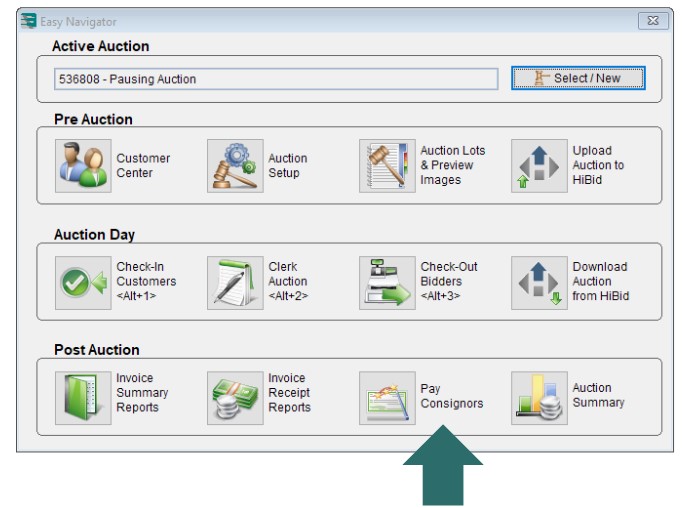
It’s really important to set up your CO Balance Options to match how your company runs auctions. Once these settings are set, you usually won’t need to change them.
Next, pick the auction(s) you want to calculate consignor payments for. Normally, you’ll choose just one, but you can pick more than one auction if you want to pay consignors for multiple auctions at the same time.
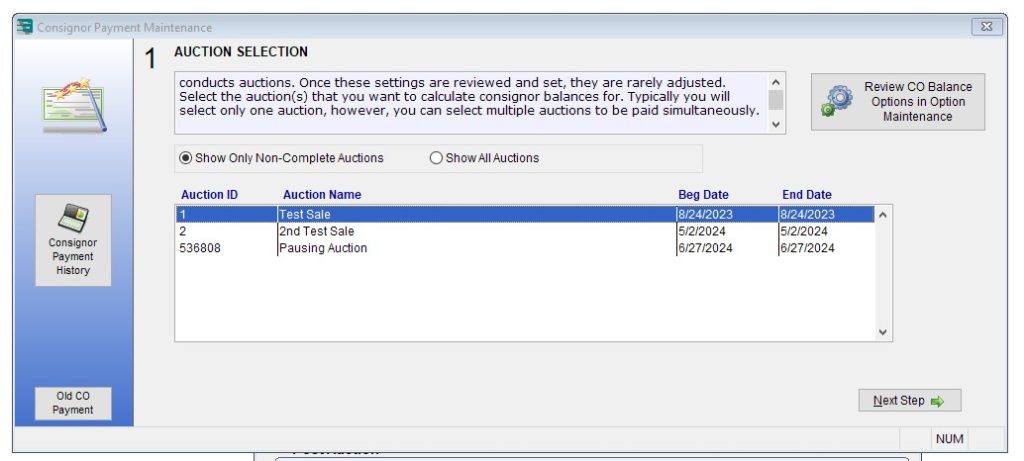
Before making payments, do a final check of each consignor’s commission schedule. If you’re using consignor deducts, it’s crucial to click the Consignor Deducts button and make sure all deducts are applied. If deducts aren’t applied, it could lead to overpaying your consignors.
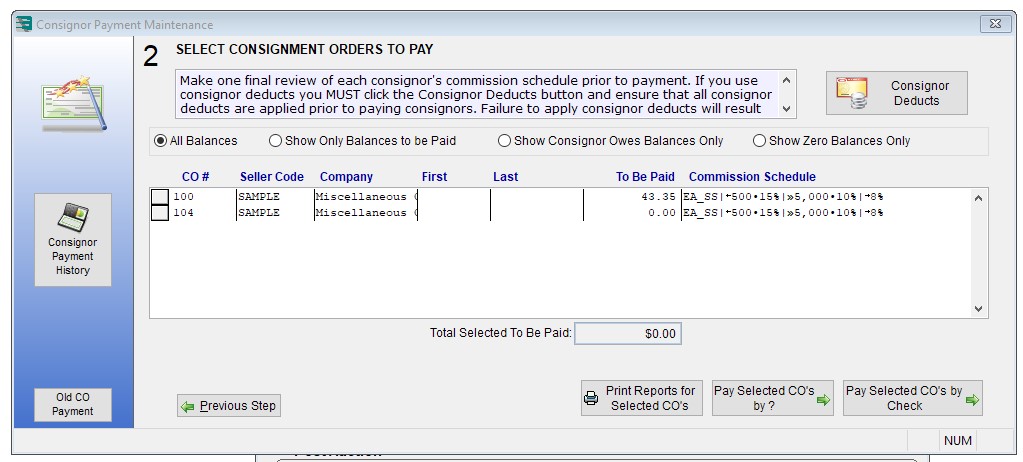
The screen above is part of the Consignor Payment Maintenance process. Here’s a breakdown of its key elements:
- Instructional Message: The text at the top reminds users to do a final review of each consignor’s commission schedule before making payments. It also highlights the importance of applying any consignor deducts by clicking the Consignor Deducts button to avoid overpaying consignors.
- CO #, Seller Code, Company, First/Last Name: This section lists the consignors (identified by CO #) who are owed payment. The Seller Code and Company columns show consignor information, while the First and Last columns display their names.
- To Be Paid: This column shows how much each consignor is owed. In this example, consignor 100 has $43.35 to be paid, and consignor 104 has a zero balance.
- Commission Schedule: This section shows the specific commission structure or schedule for each consignor, detailing how commissions are calculated based on the total sales amounts.
- Buttons/Options:
- Consignor Deducts: Allows you to apply any deducts to a consignor’s payment before processing.
- Filters: Options to view consignor balances:
- All Balances
- Show Only Balances to be Paid
- Show Consignor Owes Balances Only
- Show Zero Balances Only
- Pay Selected COs by Check: Processes payments for selected consignors via check.
- Print Reports for Selected COs: Prints reports related to the consignors selected for payment.
- Total Selected to Be Paid: Displays the total amount to be paid for all selected consignors, which is currently $0.00 in this example.
This screen is essentially a final checkpoint before processing consignor payments, allowing you to review balances, apply deducts, and initiate payment.
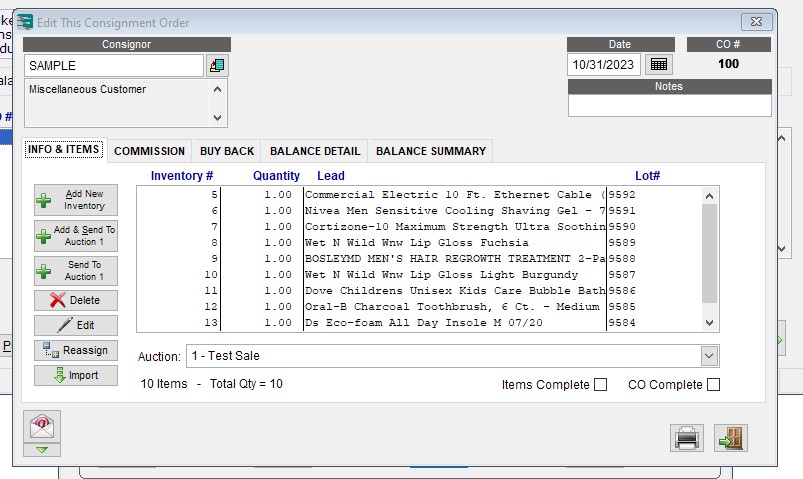
This screen is part of a Consignment Order in Auction Flex, where you can manage and review consignor details and their inventory. Here’s an explanation of its key elements:
Tabs (Center Left):
- Info & Items Tab (Highlighted): This tab is active and displays the items consigned by the consignor, their inventory numbers, quantities, and other details.
- Other tabs such as Commission, Buy Back, Balance Detail, and Balance Summary are available for further details related to commissions, buybacks, and balances.
Item List (Center):
- The Inventory # column shows the number assigned to each item in the system.
- Quantity shows how many of each item are included in the consignment.
- Lead is likely the item description, detailing what each item is (e.g., “Commercial Electric 10 Ft. Ethernet Cable” or “Wet N Wild Hnw Lip Gloss Fuchsia”).
- Lot# assigns each item to a specific lot in the auction. For example, item 1 is assigned to Lot #952, while item 13 is assigned to Lot #984.
- In this list, there are 10 items in total, with a total quantity of 10.
Buttons (Left Sidebar):
- Add New Inventory: Allows you to add new items to the consignment order.
- Add & Send to Auction 1: Sends items directly to an auction.
- Send to Auction: This button likely allows you to assign items to an auction after they’ve been added.
- Delete, Edit, Reassign: These buttons allow for item management, such as editing or deleting items or reassigning them to a different consignment or auction.
- Import: Likely lets you import inventory data from another source.
Other Options (Bottom Right):
- Items Complete and CO Complete: These checkboxes might be used to mark whether all the items or the consignment order itself are complete and ready for processing.
Balance Detail Tab
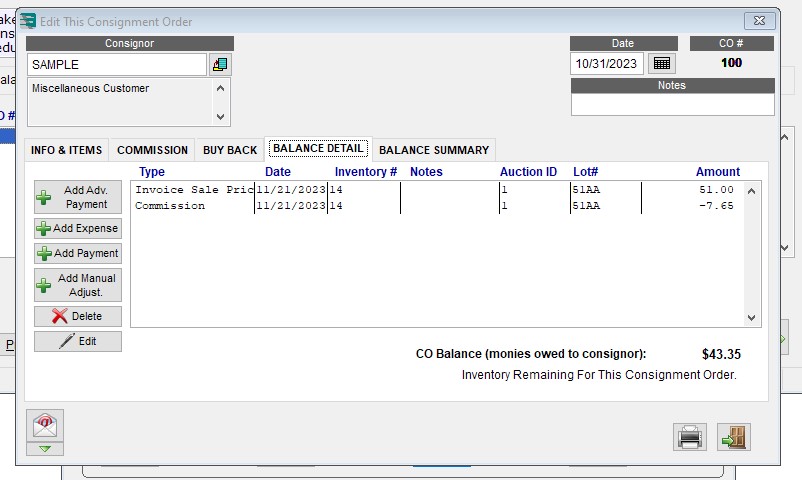
Buttons on the Left:
- Add Adv. Payment: Allows you to add an advance payment to the consignor.
- Add Expense: Lets you add an expense related to the consignment.
- Add Payment: Used for recording payments made to the consignor.
- Add Manual Adjust.: Enables you to manually adjust the consignor’s balance if necessary.
- Delete and Edit: These buttons allow you to delete or edit existing entries.
CO Balance (Bottom Center):
- Displays the total balance owed to the consignor, which in this case is $43.35 (after the commission is deducted from the sale price).
- “Inventory Remaining For This Consignment Order” suggests that there may be unsold items still pending from this consignor.
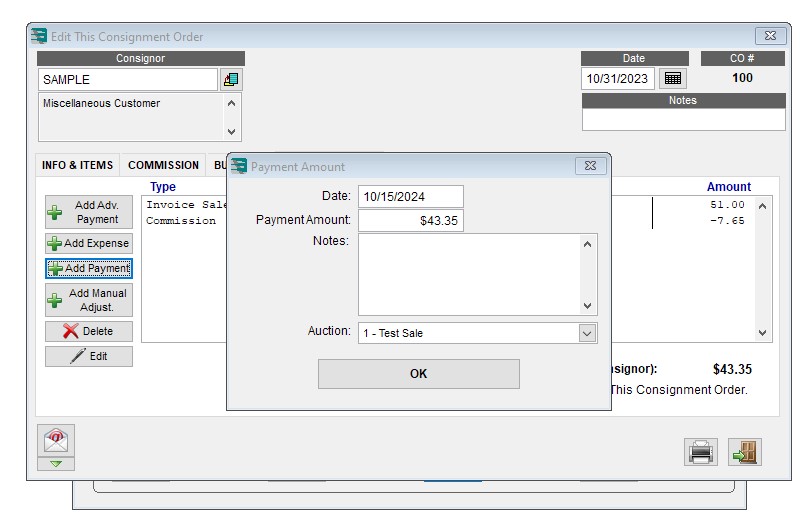
Payment Window (Center):
- This pop-up window is titled Payment Amount and is used to enter the payment details for the consignor.

